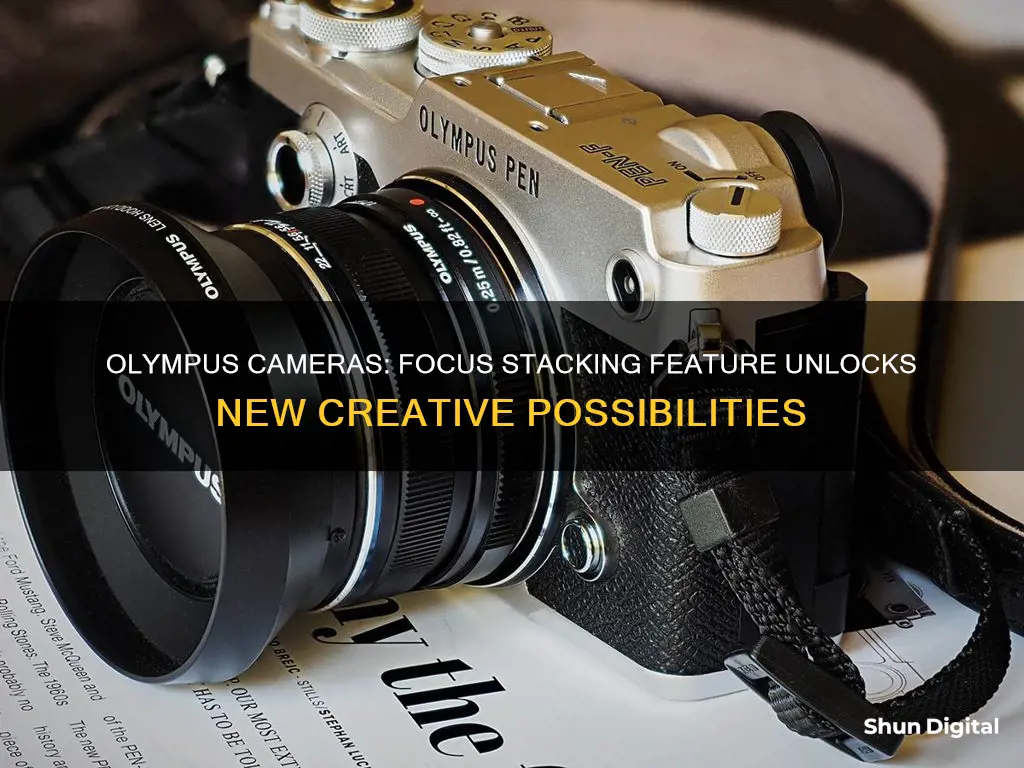
Olympus has developed built-in focus stacking in its OM-D E-M1 camera, which was introduced via a firmware update and has since been added to and improved in many subsequent camera models. The following Olympus cameras have built-in focus stacking: OM-D E-M1 Mark II, OM-D E-M1 Mark III, OM-D E-M1 (firmware version 4.0 and newer), OM-D E-M5 Mark III, OM-D E-M5 Mark II (firmware version 4.0), and the Tough TG-5 and TG-6 (stacking only).
| Characteristics | Values |
|---|---|
| Cameras with built-in focus bracketing and focus stacking | OM-D E-M1 Mark II, OM-D E-M1 (firmware version 4.0 and newer), OM-D E-M5 Mark II (firmware version 4.0), OM-D E-M5 Mark III, OM-D E-M10 IV (Focus Bracketing only), E-M10 Mark III (Focus Bracketing only), Tough TG-5 & TG-6 (stacking only) |
| Number of shots in Focus Bracketing mode | 3–999 |
| Number of shots in Focus Stacking mode | 3–15 |
| Focus differential | 1–10 |
What You'll Learn

Olympus OM-D E-M1 Mark II
The Olympus OM-D E-M1 Mark II is one of the OM-D series of cameras that has built-in focus bracketing and focus stacking. This feature was introduced with the release of the 4.0 firmware update and has been included and improved in the Mark II model.
Focus stacking is a technique that allows you to get more depth of field in a single image without using small apertures, which reduce the resolution of the image. It involves taking a series of images, with each image focused at a slightly different point on your subject. These images are then merged, either in-camera or using third-party software, to create a composite image that is sharp from the foreground to the background.
To use the focus stacking feature on the Olympus OM-D E-M1 Mark II, follow these steps:
- From the Menu, select Camera2 options.
- Select 'Bracketing'. You can bracket a variety of settings, including Auto Exposure, White Balance, Flash, ISO, Art Filters, and Focus Bracketing.
- Select 'Focus BKT' to enable focus bracketing.
- Turn on 'Focus Stacking'.
- Select 'Set Focus Differential' to choose the difference in focus position between shots. This can be set from 1 to 10, with 1 being the smallest shift in focus.
- Press 'OK' to engage the settings. The letters 'BKT' will appear at the top of the LCD, indicating that Focus Bracketing is set.
- Compose your shot and press the shutter release to capture the images.
- The camera will shoot 8 photos at the focus positions you set and then merge them into one full-resolution JPEG file.
It is important to note that not all lenses are compatible with the focus bracketing and stacking feature. Additionally, using a tripod is recommended to ensure the camera remains stable during the capture of multiple images.
Selfie Mode: Why Your Camera is Stuck and How to Fix It
You may want to see also

OM-D E-M1 Mark III
The OM-D E-M1 Mark III is a lightweight and ergonomic camera that is part of the world's most portable camera system. It has a 20MP Live MOS Sensor and features a TruePic™ IX Processor, which produces sharpness and vibrant colour. The camera also has a 5-Axis Image Stabilization feature, which delivers up to 7.0 shutter speed steps of compensation to capture crisp, clear telephoto shots, all handheld, even in low light.
The OM-D E-M1 Mark III has a focus bracketing and stacking feature. This allows you to take a series of photos with each one focused at a slightly different point on your subject. You can then use software to stack and process them to capture a greater depth of field than is possible with a single shot using a macro lens.
The focus bracketing and stacking feature is set up as follows:
- From the Menu, select the Camera2 options.
- Select Bracketing. You can bracket a variety of settings (Auto Exposure, White Balance, Flash, ISO, Art Filters, and Focus Bracketing). Select Focus BKT.
- Turn Focus Stacking On. For the E-M1X and the E-M1 Mark III, you can adjust the number of stacked shots from 3 to 15.
- Select Set Focus Differential. Choose a focus differential from 1 to 10. This determines the difference in the focus position between shots.
- Press OK repeatedly to engage the settings. You should see the letters BKT at the top of the LCD, indicating that Focus Bracketing is set.
The OM-D E-M1 Mark III has received positive reviews, with an average rating of 4.6 out of 5 stars from 211 ratings on Amazon. One review describes the camera as having "excellent image quality" and being "lightweight for travel". Another review highlights the camera's "fast face/eye autofocus" and "crazy good IBIS".
How to Access Camera Raw in Photopea
You may want to see also

OM-D E-M5 Mark III
The OM-D E-M5 Mark III is a 20MP Micro Four Thirds camera with a 20MP image sensor, Truepic VIII engine, 5-Axis IS capability, AF performance, and video shooting features. It is the first in the E-M5 line to offer on-sensor phase detect autofocus, which includes both face and eye detection modes. The camera features a 121-point hybrid autofocus system, 50MP high-res shot mode, and 10 fps burst shooting with AF-C. The E-M5 Mark III is capable of cinema (DCI) and UHD 4K video. It has a weather-sealed body and an improved Supersonic Wave Filter (SSWF) Dust Reduction on the image sensor. The camera features a 2.36M-dot OLED viewfinder with a 60 fps refresh rate. The OM-D E-M5 Mark III is a fantastic companion for travel and general photography, producing excellent images under a wide range of scenarios.
Trail Camera Battery Life: How Long Do They Last?
You may want to see also

OM-D E-M5 Mark II
The OM-D E-M5 Mark II is a small, attractive and usable 16MP camera. It is a well-built, well-stabilised, and well-sealed camera. The camera has a powerful 5-axis voice coil motor image stabilisation system that greatly reduces blur resulting from camera shake. It has a 16MP Live MOS sensor with a 40MP High-Resolution Shot Mode and 10 frames per second high-speed sequential shooting. It also has a large 2.35 million dot electronic viewfinder. The camera's movie capabilities have been greatly enhanced, not just with the addition of 1080/60p shooting and an All-I, 77Mbps compression option for 30p capture, but also with the arrival of a series of supporting features, including focus peaking, uncompressed HDMI output, a mic input socket and timecode, amongst others. The camera's autofocus is also fast, with single autofocus, continuous autofocus, and face detection. The camera also has a flip-out (articulated) screen, which is useful for taking photos from unusual angles. The camera has a slow startup time, and the menu system is not very intuitive. The camera's video quality is poor and the sensor is dated.
Baltimore Camera Tickets: Your Guide to Fight Fines
You may want to see also

OM-D E-M10 IV
The OM-D E-M10 IV is a compact and lightweight camera, weighing only 383g with the battery and memory card. It is the entry-level model in the OM-D DSLR-style lineup of Micro Four Thirds cameras, a step up from the beginner-focused E-PL series. It features a 20MP Four Thirds sensor, 5-axis in-body image stabilisation, a 121-point contrast-detect autofocus system, a flip-down touchscreen display, and an electronic viewfinder. The camera supports Wi-Fi and Bluetooth, allowing for easy wireless sharing of photos and videos to your smart device via the Olympus Image Share app.
The OM-D E-M10 IV has a variety of shooting modes, including 28 scene modes and 31 Art Filters, giving users creative freedom in their photography. It also has a Live Guide mode, which allows users to adjust settings like white balance and aperture using sliders without needing to know the technical terms. The camera has two customisable control dials, a mode dial, and three tiny buttons, two of which can be customised.
The OM-D E-M10 IV supports focus bracketing, allowing users to take a series of photos, each focused at a slightly different point, and then use software to stack and process them to capture a greater depth of field than a single shot. This feature is particularly useful for macro photography, where it can be challenging to achieve a sharp subject from front to back while maintaining a soft, defocused background.
The OM-D E-M10 IV is an excellent choice for photographers looking for a compact, lightweight, and easy-to-use camera that offers a wide range of creative features and produces high-quality images.
Mastering Dark Mode Photography: A Guide
You may want to see also







